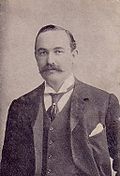Top Qs
Timeline
Chat
Perspective
Plymouth Devonport (UK Parliament constituency)
Former UK Parliament constituency From Wikipedia, the free encyclopedia
Remove ads
Plymouth, Devonport was, from 1832 until 2010, a borough constituency represented in the House of Commons of the Parliament of the United Kingdom. It covered part of the city of Plymouth in South West England, including the former borough of Devonport.
Remove ads
History
The constituency was created as Devonport in 1832, and elected two members until 1918, when the number was reduced to one. Following the amalgamation of Devonport into Plymouth, the constituency was renamed as Plymouth, Devonport.
Devonport has had a number of prominent MPs, including Leslie Hore-Belisha, Michael Foot (who began his Commons career in the seat), and the former SDP leader David Owen. One of its longest serving MPs was the National Liberal, later Conservative Dame Joan Vickers, who held the seat from 1955 until her defeat at the General Election of February 1974.
Abolition
Following the Fifth Periodic Review of Westminster constituencies by the Boundary Commission for England, constituencies in Plymouth were reorganised, with both Plymouth Sutton and Plymouth Devonport being replaced by new constituencies of Plymouth Sutton and Devonport and Plymouth Moor View from 2010.[1] The vast majority (nearly 90%) of the Plymouth Devonport constituency became part of the new Plymouth Moor View constituency; the exception was Devonport ward which became part of Plymouth Sutton and Devonport. [2]
Remove ads
Boundaries
1918–1950: The County Borough of Plymouth wards of Ford, Keyham, Molesworth, Nelson, St Aubyn, and St Budeaux.
1950–1951: The County Borough of Plymouth wards of Ford, Keyham, Molesworth, Mount Edgecumbe, Nelson, Pennycross, St Aubyn, St Budeaux, St Peter, and Stoke; and the parish of Tamerton Foliot in the Rural District of Plympton St Mary.
1951–1955: The County Borough of Plymouth wards of Ernesettle, Ford, Molesworth, Nelson, Peverell, St Aubyn, St Budeaux, St Peter, Stoke, Tamerton, and Trelawney.[3]
1955–1974: The County Borough of Plymouth wards of Drake, Ernesettle, Ford, Molesworth, Nelson, St Andrew, St Aubyn, St Budeaux, St Peter, and Stoke.
1974–1983: The County Borough of Plymouth wards of Ernesettle, Ford, St Andrew, St Aubyn, St Budeaux, St Peter, and Stoke.
1983–1997: The City of Plymouth wards of Budshead, Estover, Ham, Honicknowle, Keyham, St Budeaux, and Southway.
1997–2010: The City of Plymouth wards of Budshead, Eggbuckland, Estover, Ham, Honicknowle, Keyham, St Budeaux, and Southway.
From 1950 to 1983, the constituency included Plymouth city centre.
Remove ads
Members of Parliament
MPs 1832–1918
MPs 1918–2010
Remove ads
Elections
Summarize
Perspective
Elections in the 1830s
Grey was appointed Judge Advocate General of the Armed Forces, requiring a by-election.
Elections in the 1840s
Codrington resigned by accepting the office of Steward of the Manor of East Hendred, causing a by-election.
Grey was appointed Home Secretary, requiring a by-election.
Romilly was appointed Solicitor General for England and Wales, requiring a by-election.
Elections in the 1850s
Romilly was appointed Attorney General for England and Wales, requiring a by-election.
Romilly was appointed Master of the Rolls, requiring a by-election.
Tufnell resigned, causing a by-election.
Wilson was appointed Vice-President of the Board of Trade, requiring a by-election.
Perry resigned after being appointed a member of the Council of India, causing a by-election.
Wilson resigned, causing a by-election.
Elections in the 1860s
Seymour resigned, causing a by-election.
Buller resigned in order to contest the 1865 Liskeard by-election.
The election was declared void on petition, on account of bribery and corrupt practices,[28] causing a by-election.
Elections in the 1870s
Elections in the 1880s
Elections in the 1890s


Elections in the 1900s

Elections in the 1910s

General Election 1914–15:
Another General Election was required to take place before the end of 1915. The political parties had been making preparations for an election to take place and by July 1914, the following candidates had been selected;
- Unionist: Clement Kinloch-Cooke, John Jackson
- Liberal: Samuel Lithgow
- Labour:
Elections in the 1920s
Elections in the 1930s
General Election 1939–40:
Another General Election was required to take place before the end of 1940. The political parties had been making preparations for an election to take place from 1939 and by the end of this year, the following candidates had been selected;
- Liberal National: Leslie Hore-Belisha
- Labour: Michael Foot
Elections in the 1940s
Elections in the 1950s
Elections in the 1960s
Elections in the 1970s
Elections in the 1980s
- This constituency underwent boundary changes between the 1979 and 1983 general elections and thus calculation of change in vote share is not meaningful.
Elections in the 1990s
This constituency underwent boundary changes between the 1992 and 1997 general elections and thus change in share of vote is based on a notional calculation.
Elections in the 2000s
Remove ads
See also
Notes and references
External links
Wikiwand - on
Seamless Wikipedia browsing. On steroids.
Remove ads


